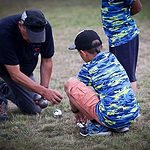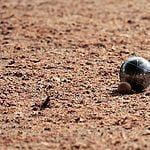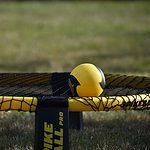In Spikeball, they say, 'Practice makes perfect.' To elevate your game, honing your aim and control is paramount. By mastering key techniques and strategies, you can boost your performance on the Spikeball court.
But how exactly can you achieve this precision and finesse in your gameplay? Let's explore some insightful tips that can take your Spikeball skills to the next level and help you dominate your opponents with calculated moves and expert control.
Key Takeaways
- Master serve precision with consistent tossing and varied angles.
- Enhance ball control using fingertips and wrist movements for accuracy.
- Experiment with grip pressures to balance control and power.
- Utilize angles, spins, and body positioning for precise aim and control.
Understanding Spikeball Basics
If you're new to Spikeball, understanding the basic rules and gameplay mechanics is crucial for mastering this fast-paced and competitive 2 vs. 2 game. Ball control is a fundamental aspect of Spikeball, as teams aim to hit the ball onto the net in a way that makes it challenging for their opponents to return. Developing your ball control skills will allow you to dictate the pace of the game and strategically position the ball for your next move.
In Spikeball, hitting the ball with precision is key to outplaying your opponents. Whether you're serving the ball or making offensive plays, accuracy in hitting the ball onto the net can create difficult angles for the opposing team. Improving your hitting technique will enhance your overall gameplay and give you an edge in scoring points.
Serving skills are essential in Spikeball, as the serve initiates each point and sets the tone for the game. A well-executed serve can put pressure on the receiving team and make it challenging for them to control the ball. Mastering different serving techniques and placements will allow you to keep your opponents on their toes and gain an advantage in the match.
Perfecting Your Spikeball Serve
To enhance your Spikeball serve, focus on precision and consistency in your technique. Position yourself perpendicular to the net to optimize serve accuracy. When serving, aim to make contact with the ball using a flat palm. This technique allows you to have better control over both the direction and speed of your serve.
Additionally, it's crucial to maintain a consistent tossing motion. By doing so, you can ensure a clean serve every time, which is essential for maintaining pressure on your opponents.
To further improve your serves, practice varying the angles and speeds of your serves. This strategy will keep your opponents guessing and make it harder for them to anticipate your next move. Remember to focus on hitting the ball cleanly on the net. Doing this will help you maximize control and accuracy, giving you a competitive edge in the game.
Enhancing Ball Control Techniques
How can you enhance your ball control techniques in Spikeball to elevate your gameplay to the next level? To improve your ball control, focus on using your fingertips to manipulate the ball with precision. Communicate effectively with your teammate to anticipate each other's movements and maintain control during rallies. Position yourselves strategically on the court to cover more ground and limit your opponents' options.
Practice hitting the ball at various angles to enhance your control over its direction. Utilize wrist movements to add spin and finesse to your shots, allowing for better manipulation of the ball. Adjust the force of your hits to develop a soft touch, enabling you to maintain control during intense exchanges. Mastering the timing of your hits is crucial; it ensures consistent and controlled ball placement on the net.
Improving Spikeball Aim Accuracy
Improving your Spikeball aim accuracy requires a keen focus on keeping your eyes on the ball at all times. To enhance your aim accuracy and control, consider the following tips:
- Adjust Your Hitting Angle and Contact Point: By modifying the angle at which you hit the ball and the point of contact on your hand, you can better control the direction of your shots.
- Practice Using Different Parts of Your Hand: Experiment with hitting the ball using various parts of your hand to develop versatility in your aim and improve your overall accuracy.
- Employ Controlled Wrist Movements: Utilize precise and controlled wrist movements to add finesse and precision to your shots, helping you direct the ball more accurately.
- Find the Optimal Power Balance: Experiment with different levels of power in your hits to strike a balance between accuracy and control, ensuring your shots are both powerful and accurately placed.
Developing Precision in Spikeball Hits
Develop precision in your Spikeball hits by focusing on striking the ball with the center of your hand to ensure optimal aim and control. When hitting the ball, aim to make contact with the center of your hand consistently. This will help you maintain accuracy and control over the direction of the ball. Practice hitting the ball at various angles to improve your ability to place shots strategically during games. Developing a consistent hitting technique is crucial for enhancing your precision in Spikeball. By refining your technique, you can increase your accuracy and control over the ball's trajectory.
Teams that prioritize precision in their playing styles often have a strategic advantage. Communicate effectively with your teammate to coordinate hits and placements. Understanding each other's strengths and tendencies can lead to a more synchronized gameplay, ultimately improving your team's overall performance. Adjusting your body positioning and footwork can also contribute to optimizing your aim and control during hits. Remember to hit the ball with the right amount of force to maintain control and placement, ensuring that your hits are accurate and effective.
Enhancing Grip for Better Control
To enhance your control and precision in Spikeball, mastering the art of gripping the ball firmly is essential. Achieving a well-executed serve and accurate shots requires a strategic approach to how you hold the ball.
Here are some tips to improve your Spikeball game through enhancing your grip:
- Experiment with different grip pressures to find the optimal balance between control and power.
- Ensure your fingers are spread out evenly around the ball for a stable and controlled grip.
- Practice adjusting your grip based on the situation to improve your aim and ball placement.
- Focus on maintaining a consistent grip throughout the game to maximize control over your shots.
Adjusting Playing Style for Aim
Adapting your gameplay style to enhance aiming precision involves strategic adjustments in body positioning and ball trajectory assessment. To improve your aim, it is crucial to align your body towards the target to ensure better accuracy. Additionally, focus on analyzing the trajectory of the ball coming towards you; anticipate its path and make real-time adjustments to your aim. When playing in a team of two, clear communication is vital to coordinate your movements and ensure both players are on the same page regarding aim and strategy. Furthermore, adjusting your playing style for aim includes using finesse in your hits rather than relying solely on power. By practicing hitting the ball at various angles, you can develop a versatile aiming technique that allows you to adapt to different game situations effectively.
| Adjusting Playing Style for Aim |
|---|
| 1. Align body with target for accuracy |
| 2. Analyze ball trajectory for real-time adjustments |
| 3. Use finesse over power for improved aim |
Utilizing Angles for Improved Aim
To enhance your aiming precision in Spikeball, mastering the utilization of angles is key to strategically outmaneuvering opponents on the net. Understanding how to use angles effectively can significantly impact your gameplay.
Here are some tips to help you make the most out of angles:
- Create Strategic Shots: By adjusting the angle of your hits, you can create shots that are difficult for your opponents to return effectively.
- Hit the Ball Precisely: Utilize angles to aim the ball precisely where your opponents aren't positioned, increasing your chances of scoring points.
- Deceive Opponents: Changing the angle of your hits can deceive opponents, making it challenging for them to anticipate your moves.
- Increase Control: Mastering angles grants you more control over the ball's direction and trajectory, giving you an edge in Spikeball matches.
Experiment with different angles during gameplay to discover the most effective and unpredictable ways to hit the ball, keeping your opponents on their toes.
Mastering Spin Techniques for Control
Incorporate spin techniques in your Spikeball gameplay to enhance control and manipulate the ball's movement effectively. By mastering spin techniques, you gain the ability to dictate the ball's trajectory and behavior, giving you a strategic advantage over your opponents. Spin can be applied in various ways, such as topspin to make the ball dip quickly or backspin to maintain a straighter path. Manipulating the spin on the ball requires precise adjustments to the angle and force of your hits.
Control is at the core of spin techniques, as it allows you to deceive opponents with unexpected movements and adds complexity to your plays. When executed correctly, spin can make it challenging for others to anticipate the ball's path, giving you the upper hand in the game. Practice different spin techniques consistently to improve your mastery over the ball's rotation and enhance your overall control and accuracy in Spikeball matches. Remember, mastering spin techniques is a crucial component for elevating your gameplay to the next level.
Implementing Strategies for Aim and Control
Utilize precise body positioning and coordinated arm movements to enhance your accuracy and control in Spikeball gameplay. When strategizing for better aim and control in the Spikeball game, consider the following key points:
- Positioning: Stand with your feet shoulder-width apart and point them towards your target. Keep your body parallel to the net to ensure a strong foundation for hitting the ball accurately.
- Hitting Angle: Adjust the angle of your arm swing based on the direction you want the ball to go. A higher arm angle results in a downward shot, while a lower angle produces an upward shot.
- Peripheral Vision: Use your peripheral vision to track the ball's movement and anticipate its trajectory. This will help you position yourself correctly to make precise hits.
- Timing: Time your hits carefully to control the direction and speed of the ball. Practice hitting the ball at different heights and distances to improve your aim and control.





